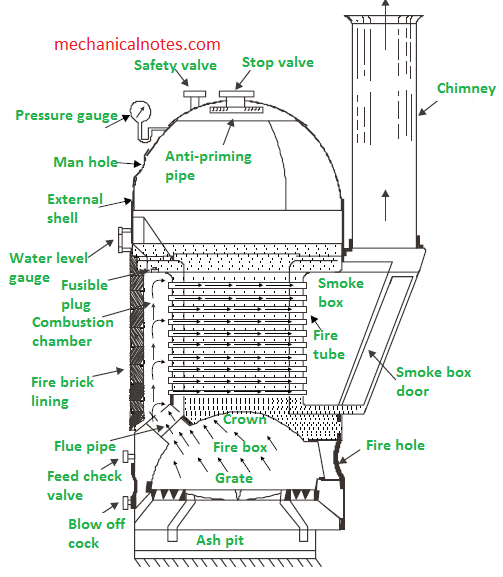Table of Contents
Geothermal Energy
Geothermal energy is the heat energy stored inside the earth that originates from the planet’s formation and the radioactive decay of minerals.
- It can be found in the form of steam, hot water, or hot rocks beneath the Earth’s surface.
It is a renewable source of energy because heat is continuously produced inside the Earth.
- The term Geothermal comes from two Greek words ‘ GEO ‘ and ‘ THERMOS ‘.
- The Greek word ‘ GEO ‘means to the earth while ‘ THERMOS ‘ meant heat release from the earth.
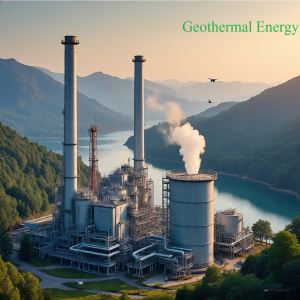
Geothermal energy can be a clean energy source, as it has a much lower environmental impact compared to fossil fuels.
- It can be used for direct heating, cooling, and electricity generation in many different applications.
- It is produced because of the fission of radioactive materials in the earth’s core and some places inside the earth become very hot. Hence, they are called hot spots.
Definition of Geothermal Energy
Geothermal energy is an enormous amount of heat energy that is available inside the earth.
Sources of Geothermal Energy
- Following are the sources of it:-
1. Hydrothermal resource
2. Vapour dominated resource
3. Hot dry rock resource
4. Geopressure resource
5. Magma resource
1. Hydrothermal resource
- These are the deposits of hot water and steam at lesser depths and these can be extracted by means of production well.
- High temperature water and steam is used for the generation of electricity, otherwise it is used for space heating.
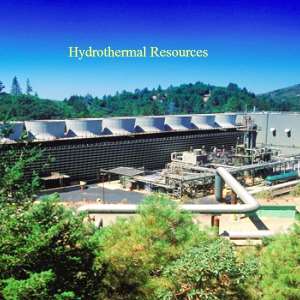
- This may be seen that only a part of the rock is permeable constituting the geo-fluid reservoir, so the field is able to produce commercially a viable resource.
- It simply classified into two parts:
A. Hot Water Fields
B. Wet Steam Fields
A. Hot Water Fields
- At these locations hot water below 100°C emit out as hot spring and the geothermal aquifers being covered by confining layers to keep the hot water under pressure.
- For e.g. Sahestra dhara near Dehradun, Sacred kund at Badrinath in Uttarakhand, Pro river valley, etc.
B. Wet Steam Fields
- The pressurized water is at more than 100°C and contains small quantities of steam and vapour in the geothermal reservoir.
- Sites where the steam escapes through cracks in the surface are called fumaroles.
- An impermeable cap-rock prevents the fluid from escaping into atmosphere and drilling is carried out to bring the fluid to the surface.
- The fluid is used to produce steam and boiling water in predominant phase.
- For e.g. Low Azufre, Deing, etc.
2. Vapour dominated resource
- It produces dry saturated steam of pressure above atmospheric pressure and at high temperature about 350°C.
- Water and steam coexist, but steam is in dominant phase and regulates pressure in the reservoir.
- Steam obtained from such a geothermal field directly drives a turbine.
- For e.g. Kamojang, Malsukawa, The Geysers California. etc.
3. Hot dry rock resource
- This is a geological formation with high temperature rocks at 650°C, heated by conductive heat flow from magma but contains no water.
- To trap its energy the impermeable rock is fractured and water is injected to create an artificial reservoir.
- Water circulates and hot fluids return to the surface through the other drilled well as steam and hot water, which are used to generate electricity.
4. Geopressure resource
- It contains moderate temperature brines containing dissolved methane and these are trapped under high pressure in a deep sedimentary formation sealed between impermeable layers of shale and clay at depths.
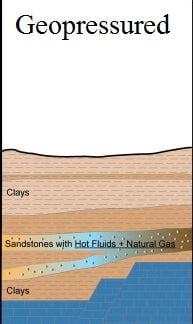
- When trapped by boring wells, three sources of energy are available:-
A. Thermal
B. Mechanical as pressure
C. Chemical as methane
5. Magma resource
- It is a molten rock at temperature ranging from 900°C to 1600°C. This hot viscous liquid comes out from active volcanic vents and solidifies.
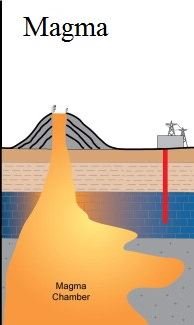
- It may from reservoirs at some depth from the earth’s surface and magma chambers represent a huge energy source.
- The existing technology doesn’t allow recovery of heat from these resources.
- Also read on touching the link:-
- Solar Cell in details
- Networking in details
- Green Concrete in details
- Heat Treatment
- Heat Transfer
- Energy
- Heat
- Light
About related to machine click on the link
Types of Geothermal Energy Power Plants
- Following are the types of geothermal energy power plants:-
1. Vapour Dominated Power Plant
2. Liquid Dominated Power Plant
1. Vapour Dominated Power Plant
- In a vapour dominated power plant, steam is extracted from geothermal wells, passed through a separator to remove particulate contents and flows directly to a steam turbine.
- Steam then operates the turbine coupled with the generator is at a temperature of about 245°C and pressure 7 bar which are less than those in conventional steam cycle plants.
- Thus, the efficiency of geothermal plants is low, i.e., about 20 %.
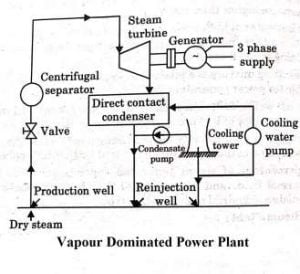
- Exhaust steam from the turbine passes through a condenser and the water so formed circulates through the cooling tower.
- It improves the efficiency of the turbine and controls environmental pollution associated with the direct release of steam into the atmosphere.
- Waste water from the cooling tower sump is reinjected into the geothermal well to ensure continuous supply.
2. Liquid Dominated Power Plant
- These plants are also called wet steam plants because they give wet steam i.e., a mixture of hot water and steam under high pressure.
- There are two types of liquid dominated power plants:-
i. Flashed Steam System
ii. Binary Cycle System
i. Flashed Steam System
- It is preferred for high temperature mixture of geothermal brine and steam, with low dissolved impurities.
- Geothermal fluid passes through a flash chamber where a large part of the fluid is converted to steam.
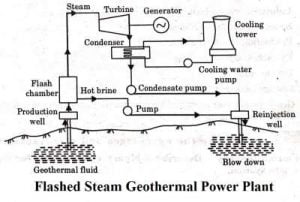
- Dry saturated steam passes through the turbine coupled with the generator to generate electric power.
- Hot salt water from the flash chamber and the turbine discharge from the condenser are reinjected into the ground and reinjection of the spent brine ensures a continuous supply of geothermal fluid from the well.
ii. Binary Cycle System
- A binary cycle is utilized where geothermal fluid is hot water with temperature less than 100°C.
- This plant operates with a low boiling point working fluid in a thermodynamic closed Rankine cycle.
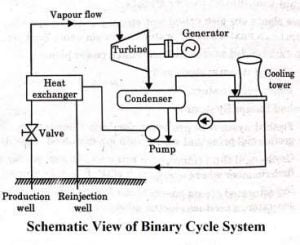
- Hot brine from underground reservoir circulates through a heat exchanger and is pumped back to the ground.
- In heat exchanger, hot brine transfers its heat to the organic fluid thus converting it to a superheated vapour that is used in a standard closed Rankine cycle.
Environmental Impact of Geothermal Energy
- Geothermal energy is not completely pollution free energy.
- The main adverse environmental effects are air pollution, thermal pollution, surface disturbance, physical effects caused by fluid withdrawal.
- At geothermal site, the air pollution is the major problem because of emission of poisonous gases such as hydrogen sulphide ( H2S ), ammonia, methane, Carbon dioxide ( CO2 ) etc.
- The extraction of energy from hot dry rocks or molten magma, it is necessary to force water down boreholes as a working fluid and return it to surface to use in turbine.
- If the underground reservoir is highly permeable, there is no way to know how much water is returned to the surface.
- A large volume of flash steam getting away into the atmosphere could cause dense fog to occur.
- At geothermal site, some harmful substances may escape into the air.
- These may contain radioactive materials also thus systematic monitoring is advisable.
- Geothermal water contains dissolved solids.
- The amount of dissolved solids is in the range of 300-1500 ppm of which silica amounts to 25-50 %.
- The possible solution is reinjection or disposal into sea through ducts and channels and also the use of evaporator ponds.
Types of Geothermal Fields
- There are three common types of geothermal fields:-
1. Hot Water Fields
2. Wet Steam Fields
3. Dry Steam Field
1. Hot Water Fields
- Hot water field, containing a water reservoir at temperature ranging 50- 100 °C.
- Such fields without much steam content can be useful for house heating and agricultural purposes the temperature gradient in this field is less.
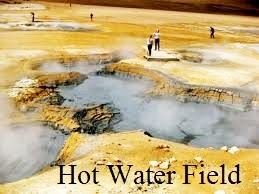
- The reservoir contains water in the liquid phase below the boiling point of water under pressure.
- On the surface, there are often thermal springs whose temperature is near the boiling point of water. These fields occur at depth less than 2 km.
- The geyser plant of USA is the largest plant in the world today.
2. Wet Steam Fields
- The wet steam fields contain pressurized water in reservoir at temperature higher than 100°C.
- When hot water at high pressure is brought to the surface, its pressure is sufficiently reduced and some water will get flashed into steam and remaining in the form of boiling water.
- The resulting mixture is a mixture of water and steam. Such fields are suitable for power generation.
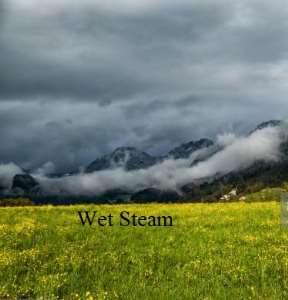
- When the well is drilled at such locations, the pressurized water rises into well because of less pressure above the well.
- The vapour is used directly for producing power while the hot water gets separated in the separator and is used for thermal applications.
- The percentage of steam generated depends upon the available geothermal fields and more than 90 % of hydrothermal reservoirs exploited on industrial scales.
3. Dry Steam Field
- These fields are similar to wet, steam fields but heat transfer from the depth is much higher.
- These reservoirs produce superheated steam at pressure above atmosphere.
- The permeability of these fields is lower than wet fields.

- When the well is drilled up to the reservoir and extraction of fluid starts, a depressed zone is formed at the bottom of the well, that enhances the boiling of water surrounding the rocks.
- The steam flows through the dry bottom area and starts expanding and gets cool. But the heat added by surrounding rocks at high temperature keeps the steam at superheated state.
- The degree of superheating may reach up to 100°C.
Comparison Between Geothermal Power Plant & Thermal Power Plant
| S.NO. | Geothermal Power Plant | Thermal Power Plant |
| 1. | It uses inexhaustible source of energy. | It uses exhaustible source of energy. |
| 2. | It is more environment friendly. | It is less environment friendly. |
| 3. | These power plants in some dangerous cases can cause earthquakes. | There is no much problem. |
| 4. | It is mainly used for power generations process. | It can be used for various industrial processes. |
| 5. | Setup cost is high. | Setup cost is low. |
| 6. | By products of those plant are not used. | By products of these plant can be used. |
| 7. | These plants are less flexible. | These plants are more flexible. |
| 8. | Specified area are required. | No such restriction. |
Geothermal Energy Scenario in India
- There are around 340 known thermal areas in India, each represented by hot or warm springs.
- Many more areas are being discovered and reported, in the 12 well defined geothermal energy provinces.
- The total stored heat potential of the 93 systems considered is 36.87 × 1018 calories, which is equivalent to the combustion energy of 5160 million tones of coal or 25440 million barrels of oil. 38 of these frameworks are of high temperature type whose heat energy could be considered for electrical power generation.
- Their estimated cumulative potential for power generation is of the order of about 500 MW for 100 years or 1650 MW for a 30 years period of utilization.
- Of the remaining thermal areas, 49 are of intermediate temperature and 6 are of low temperature geothermal energy resources type which could best be used for non- electrical applications.
- Their cumulative stored heat potential is 19.37 x 108 calories out of which only 1.135 x 108 calories could be beneficially put to practical utilization.
- Since most of the non – transportation energy needs could be met at temperature below 150 – 200 °C and if the potentials of all 93 systems are considered for non – electrical applications the cumulative beneficial heat will be of the order of 2.185 x 108 calories.
- If this heat is to be supplied from electrical power, 10,000 MW of electricity could be required for 30 years period. Thus these springs have a potential to substitute about 10,000 MW of electricity could be required for 30 years period.
- This is roughly 10 % of the total anticipated power production in India by the turn of the century.
- Several pilot projects were undertaken by Geological Survey of India in collaboration with other agencies such as N. A. L. Bangalore, IIT Delhi in the geothermal energy area of North – West Himalayan province, which have conclusively proved the vast potentialities for exploitation.
- A pilot project for ” space heating ” at Puga, in Ladakh in 1975 at an altitude of 4500 m, involved construction of a shed and using steam at 125 °C , at 2.5 kg/ cm² from a nearby geothermal energy well for heating the space, with the help of an aluminium finned, copper, tube radiator converter.
- A difference of 25 °C was achieved with respect to the ambient temperature.
- Another project named ” Green house pilot project ” at Chumathang, in 1974, was commissioned.
- It utilizes hot water from a nearby geothermal energy well to heat the soil and environment of a green house separately.
- Heating of soil was done by laying zig – zag pipes below the complete area of soil and allowing geothermal energy fluid to pass through them.
- This project proved that 41 varieties of plant including flowers, creepers, vegetables, and trees can be grown even at the peak of winter using geothermal energy and constructing green house, whereas normally no germination is possible for 10 months in a year in this area.
- This project was undertaken by Geological Survey of India in collaboration with ” Field Research Laboratory “ at Leh.
- A third pilot project ” cold storage plant “ has been recently commissioned at Manikaran by the joint collaboration of Geological Survey of India, IIT Delhi, and Himachal Pradesh Government.
- This plant avails the hot water at 90 °C from a nearby geothermal energy well and cold water at 10 °C from the Parbati river, flowing nearby, and is capable of removing 400,000 kcal/hr of heat to obtain a permanent cold storage temperature of 5 °C.
- This can only possible if successful help the local farmers to store nearly 15,000 tonnes of fruits and potatoes after the harvest and enable them to sell them throughout the year at a uniform price.
- A 5 kw pilot power plant is under fabrication at National Aeronautical Laboratory, Bangalore.
- This plant will run on geothermal energy which will be recovered from the hot springs at Manikaran in Himachal Pradesh. This will utilize a binary cycle process using R – 113 as the working fluid.
- All these studies have confirmed the suitability of the resources for utilization for various purposes. Plants are being made to undertake further research and development studies in the area of geothermal energy.
Applications of Geothermal Energy
Geothermal energy is used for electricity generation via power plants.
It can be used to create and maintain suitable conditions for fish farming and aquaculture.
It can be used to heat individual homes or pools or provide hot water for various uses.
It warms soil, accelerating plant growth and improving crop quality in agricultural settings.
It is directly used for therapeutic baths and at spa facilities, providing natural heating for relaxation.
It can be used to melt snow and ice on roads and sidewalks, improving safety and accessibility in cold climates.
It is used to convert seawater into fresh water, providing a sustainable solution for water-scarce regions.
It has wide-ranging applications, from heating homes and greenhouses to generating large-scale electricity.
It is used in various industries, such as food processing, paper production, and chemical manufacturing, to provide heat and reduce energy costs.
It can be used directly to heat and cool buildings by circulating fluids through underground loops that exchange heat with the stable temperature of the ground.
Advantages of Geothermal Energy
- Feasibility of modular approach represents a lot of opportunities for improvement of relatively quick, cost effective geothermal energy projects.
- The emission of CO2 and SO2 by geothermal energy plants is far less compared with conventional fossil fuel based power plants.
- It is almost pollution free.
- It is an inexhaustible source of energy.
- More dependable source of power generation than other renewable energy sources.
Disadvantages of Geothermal Energy
- Geothermal fluids often contain significant quantities of gases such as CO2, CH4, N2, NH3 and H2S. The H2S as well as dissolved chemicals can sometimes be acidic. Due to this, corrosion, erosion and chemical deposition may be issues which require attention at the design stage and during operation of the geothermal energy system.
- Noise pollution because of drilling.
- Well casings and pipelines can endure erosion and / or scale affidavit, and turbines, especially blades, can suffer damage leading to higher maintenance costs and reduced power output.
- Plants are located at far distance from location of application. This causes more losses in power as well as thermal losses or pressure drops in pipe, while transferring hot fluids for direct use.
- The underground water depletion may occur at low rainfall areas if water is not reinjected back.

